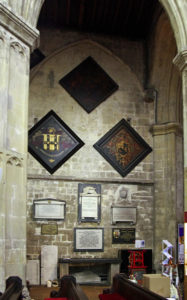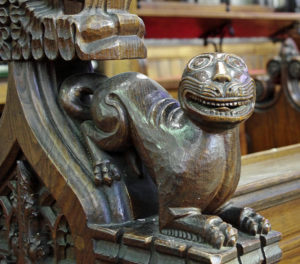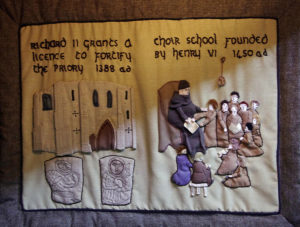Bridlington Priory was once one of the largest and wealthiest Augustinian Priories in Yorkshire with land stretching from Blubberhouses in the north, Askham Richard in the west and down to Spurn Point.
The monastery was founded in 1113 on the site of an earlier Saxon church by Walter de Gant, who was Lord of the Manor of nearby Hunmanby. His tomb is still in the south aisle.
The old town of Bridlington grew up around the priory. The priory was fortified in the C12th during the conflict between Stephen and Matilda, with four gateways into the monastic buildings.
John de Tweng, a C14th prior and in 1401 became the last Englishman to be canonised before the Reformation. His shrine quickly became associated with several miracles. Pilgrims and royalty flocked to the tomb. The last prior was one of the ringleaders in the disastrous Pilgrimage of Grace in 1536. He was imprisoned in the tower of London and executed at Tyburn. The priory was dissolved in 1537 and all the priory buildings were pulled down and used for building stone. The shrine and tomb of St John were burned in the Market Place. Only the nave survived as this had belonged to the town and was used by them and became the parish church. Across Church Green is the Bayle, the last surviving gatehouse into the fortified priory. This now houses a museum of local history.
By the C18th the church buildings were getting in a poor state of repair and there were a series of restorations culminating in a major restoration in the C19th by Gilbert Scott. He redesigned the roof and was responsible for adding the tops to the two west towers.
It is a splendid building set in its graveyard, and almost too big to photograph. The two west towers are a local landmark and are unusual because they are asymmetrical. The north west tower is early English. The south west tower is perpendicular. Between them is the glorious perpendicular west window which is described as being the largest in the north.
At the base of the north west tower is a Norman doorway, one of the few bits of the Norman church to survive. Next to it is a splendid Perpendicular doorway set under a crocketed ogee arch and carved arches. On either side are empty niches for statues.
The north wall is the oldest part of the church and is early English with its lancet windows and heavy buttresses. The north porch with its room above, corner turrets and empty niches for statues would have been an importance entrance into the church.
The south wall is later and the prior’s buildings were originally built onto it. These are now a blank wall. Above is the clerestory with large Decorated windows. The massive buttresses on either side of the east window are all that survive of the transept crossing of the pre-reformation abbey.
Inside it feels a very large church as there is no chancel arch separating nave and chancel. The arcading on the north wall is 1250. Clustered pillars with twelve shafts and plain capitals support pointed arches. Above is an open triforium with a gallery running the length of the church. Above this are the clerestory windows added in 1270. The stone is brilliant white and shine in the sunshine and a marked contrast to the dark wood roof.
The stained glass windows in the massive east and west windows flood the church with colour.
Side aisles are narrow and the walls are covered with memorial stones and wooden hatchments. At the back of the south aisle is the Founder’s Tomb, a carved slab of black Tournai marble. This is thought to be the marble slab covering the tomb of walter de Gant whose remains were buried before the high altar.
Standing on pale stone legs this has a carved top. At the top are two dragons or wyverns. Below is a stylised representation of a church. Below this is what is described as a fox and a pigeon attempting to drink from a narrow topped vessel. At the bottom is a lion. Near it is a board listing Priors from 1124 to the present.
At the back of the north aisle is the C14th font made from Frosterley Marble. The wooden canopy was made in 1955 by Robert Thompson of Kilburn, the mouse man. Beyond is a tapestry made by members of the congregation which uses appliqued panels to tell the history of the priory from 1086 to the present day.
The wooden pulpit on a stone base, dates from 1850. The panelling, canopy and spiral staircase with wrought iron balustrade, were added in 1960 and are again the work of Thompson of Kilburn. The coats of arms on the gate at the base of the stairs are of the archiepiscopal sees of York and cCanterbury with the three Bs of Bridlington. Round the top of the canopy are carved scenes from the life of Christ.
Separating the chancel from the side chapels is carved oak parclose screen. In front are three tiers of choir stalls carved by Thompson of Kilburn. Those on the back have carved angels playing instruments between the seats. The curate’s chair has carved ends with mythical animals.
The simple table altar has a carved reredos made from Caen stone. Above, the east window contains C19th stained glass illustrating the tree of Jesse. At the centre bottom is Jesse. Above him are King David and King Solomon. At the centre top is the Virgin Mary and the Christ Child. From Jesse, a branch of a tree can be traced to the figure of Mary and Jesus in the top window.
To the right of the chancel is the small chapel of St John of Bridlington which is used for private prayer. The altar has blue and gold drapes around it and the woodwork is by Thompson of Kilburn.
This is a splendid building and well worth visiting. It is fully accessible for people in wheelchairs. Check the website for opening hours which vary from winter to summer. There is a small shop. Members of the congregation welcome visitors and are very proud of their priory and keen to talk. There are quiz sheets to find the 18 Thompson mice scattered around the church.
There is parking on the road in front of the church. The post code of the church is YO16 7BB and the grid reference TA177680.
There are more pictures of Bridlington Priory “here.”:http://wasleys.org.uk/eleanor/churches/england/yorkshire/east_riding/east_one/bridlington/index.html










